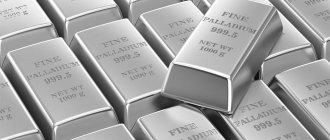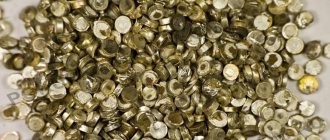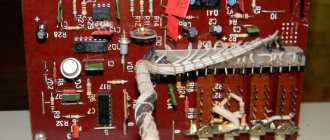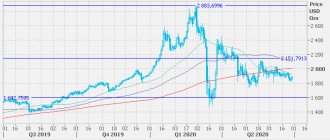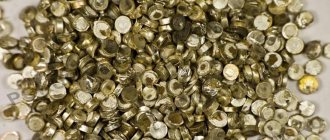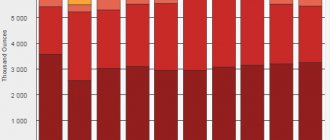Almost any radio-electronic equipment or device that was produced in the Soviet Union contained parts containing precious metals. Platinum and palladium have a small percentage in radio components. This need was dictated by the fact that it was necessary to ensure the longest service life of the device and its correct, accurate operation. Today, in many RECs, they have already found a replacement for gold and silver with cheaper elements of the periodic table, but platinum and palladium are still used in many areas of industrial production, which is due to their unique chemical properties.
Application of platinum
Platinum, a chemical element on the periodic table, is a native silvery, white metal similar to silver. It differs from silver in its refractoriness, resistance to acids and corrosion. Indispensable when it comes to the production of RECs such as capacitors, resistors, switches, connectors, used in almost all types of equipment and devices. Scientists say that platinum is like salt in cooking. Without platinum, the development of electrical engineering, radio engineering, precision instrument making, as well as instruments and equipment for the aerospace sector is impossible. Used in all modern technologies. Platinum is used both as an alloy and as a pure metal.
Pure platinum. Application
- Electrolysis (mesh, cathodes), dies, production of winding wire, thermocouples, electrical resistance furnace;
- In chemical production (catalysts for the production of acids (sulfuric, nitric), ammonia oxidation, for dehydrogenation, hydrogenation, alcohol reduction;
- In jewelry production;
- Coating of dishes, industrial baths, tanks with platinum.
Platinum in alloys. Application
- In radio electronics – production of contacts, vacuum devices, electrodes, thermocouple wire.
- In the chemical industry - production of catalysts, electrodes, meshes, filters.
- In medicine: dentistry, traumatology, surgery (production of prostheses, instruments).
This is just a small part of the uses of this precious, unique metal. So, today platinum has begun to be used in the automotive industry to create air purifiers, filters, and neutralizers.
Radio components containing gold
Gold-bearing deposits are developed if the content of the precious element is at least 1 gram per ton of rock. In one chip there is from 1 to 5 percent yellow metal. The leads of the part, enclosed in a ceramic case, are coated with gold.
If it is made of plastic, the content of valuable raw materials is less - from 0.2 to 1 percent. In transistors, the precious element is about 2 percent. The substrate located under the conductor is made of gold.
But capacitors break all records. Their size is approximately equal to a three-liter jar. One such part contains approximately 8 grams of yellow metal. In addition, there is also 50 grams of silver. However, only capacitors used in military equipment - generators and radio signal transmission stations - are equipped with expensive filling.
Some gold can also be extracted from radio tubes. The precious element is deposited on a grid located near the cathode. The latter, when the lamp is operating, heats the grid. When exposed to heat, it begins to release electrons. This disrupts the operation of the product.
Therefore, the radio component needs to be coated with gold . Spraying from it is also found on the legs of objects of consecration, but this only applies to old samples, decades old.
Several microns of precious raw materials were previously applied to connectors of all types of semiconductors, such as diodes, optocouplers, thyristors, and zener diodes. Gold is rarely found in resistors. However, some of them, along with silver, also contain a little yellow metal.
These are the standards by which radio components were manufactured in the USSR in the 70s and 80s of the last century. Gold is also found in modern radio components . However, it is impractical to extract hundredths of a gram from an item for which tens, or even hundreds of thousands of rubles were paid. Let the old parts be used - that's another matter.
Most often, radio components containing gold are found in old-style computers, switching devices, and radio equipment. Electronic computing units of the SM and CE series should be of primary interest to applicants. One such machine contains from 0.2 to 10 kilograms of gold. Some military equipment can boast of the same thing.
Beginners will find it useful to list not only the general names of radio components equipped with gold “filling,” but also specific model designations. So:
Transistors KT201, KT203, KT3102, KT301, KT306, KT605. All of them are equipped with golden colored legs.
KT802, 808, 803, 809, 812, 908. We need samples produced before 1986. In later models gold was not used.
KT907,904, 606. Externally they have no gold elements and no yellow color. However, valuable raw materials are actually present.
But KT602, 604, 611, 814, 815, 816, 9909 have gold cases.
Relay RES9, 10, 15, 22, 34, RPS24, 32, 34, RKG15.
Microcircuits K142EH, K50, K56PY2, AOT101, K145, also known as the “white spider”.
Chips K133, 134, 178, 249, 564, 565, K140, 157, 217.
Diodes of the D226 series and similar ones.
Capacitors Km3, 4, 5, 6, 10, 11, 12, 13, 14, 15, 16, 17, 52-1, 52-7, K53-1, 53-6, 53-7, 53-10, 53 -15, 53-16.
Resistors PTP1, 2, PLP2, 6, PP3-40, 3-41, 3-43, 3-44, 3-45, 3-47, KSP1, 4, KSU1, KSD1, KPU1, KPP1, SP5-1, 5 -2, 5-3, 5-4, 5-14,5-15, 5-16, 5-17, SP3-19, 3-44.
Connectors SNP59-64V, SNP59-96R, GRPPM7-90Sh, RPPG2-48.
Switches TV1, P23G, Pg2-5, 2-6, 2-7, 2-10, P1T3-1V, PR2-10, PKN8, PT33-26, PP8-6, PPK2.
Palladium and its uses
Palladium is a chemical element, a precious metal, also silvery white in color. Designated in the table as Pd. It was isolated from platinum ore by the English chemist Wollaston (1803). Palladium is widely used for the manufacture of capacitors, some types of relays, contacts, and in microcircuits. The metal was also used in Soviet times for the production of radio-electronic components, and it is still used today. It is most actively used in the electronic, chemical, military, and aerospace fields. Scientists are conducting experiments to expand the areas of use of this precious metal.
Microcircuits and capacitors contain a palladium-platinum alloy to improve the stability of the functioning of parts in any environment, including at a significant increase in temperature.
What radio components contain
Precious metals were used in the production of Soviet devices, since at that time the market was focused on high quality. Noble metals are resistant to adverse environmental conditions, do not wear out and do not oxidize. In which radio components gold, palladium and platinum can be found, you can guess by their importance in devices.
The more significant the part, the higher the likelihood that it contains precious components. Potentiometers or capacitors, switches, transistors, microcircuits, connectors, resistors, radio and generator tubes contain noble metals, which prolongs their service life.
Approximate percentage of palladium in radio components.
| Item name | Palladium percentage (%) |
| Spirals and windings of flux chords for markings KSP, KSU, KSD and potentiometers PTP-2 | 80 |
| KSP relay contacts, RES relays 7 and 8 | 78 |
| Capacitors PPML IM | 60 |
| Contacts from resistors SP5-14 22 Ohm and SP5-14 33 Ohm | 58 |
| Pins of the contact group of resistors SP5-17-10 Ohm, SP3-37 | 28 |
| Roller winding and contact group of resistors, PP3 from 40 to 47 | 20 |
| Contact areas, SP5 circles | 18 |
Which radio components contain the most Pd?
- Radio technical scrap of military electronic equipment.
- Palladium capacitors (usually green) marked KM.
- Metal core resistors.
- Oscilloscope wire types C114 - 125, C1-9-9.
- Switch contacts.
Most semiconductor devices contain platinum group metals, but in quantities that are insignificant for refining.
Where else can you find it?
Palladium can be extracted from computer parts. The same principle applies here - the older the unit, the greater the chance of getting a good metal yield.
Modern microcircuits contain a Pt-Pd alloy, but the yield of palladium from these parts will be insignificant. But it’s worth looking for pioneer chips.
Details - the main sources of precious metals
Most precious metals can be found in electronic control units of various equipment created by the defense industry, old-generation computers, radio and television equipment. Precious metals such as silver, gold, platinum, as well as iridium and palladium can most often be found in such radio-technical scrap. In some cases, expensive rare earth metals were and are used in the production of radio equipment.
Types of radio components
Analyzing the content of precious metals in radio components according to the reference book, we come to the conclusion that the most valuable in this regard are:
- Capacitors. Valuable elements are present in relatively large quantities in capacitors produced in the USSR. Ceramic and tantalum capacitors are also rich in precious metals.
- Microcircuits. Such parts marked 133, 564, 1533, 155, 142, 530 and 134 are especially beneficial when delivered as radio-technical scrap.
- Generator lamps. Precious metals are present in products marked GMI, GI, GS and GU.
- Transistors. Almost all types of such radio components, both Soviet-made and modern Russian or foreign analogues, are suitable for processing to extract precious metals.
- Resistors. It is necessary to select electrical resistances from the SP5 (1−44), SP3 (19−44), PP3 (40−47) series.
- LEDs. Only those samples that have yellow leads are suitable for extracting precious metals.
- Potentiometers. Exclusively with an abbreviation denoting product series: PLP, PTP, PPMF and PPLM.
- Breakers (Relays). Almost all types of such radio components are processed for the purpose of extracting rare elements.
This list does not represent a complete and final list of radio components containing precious metals. Elements containing gold are present in the simplest electrical parts: buttons, switches or connectors.
A separate point that must be paid attention to is the color of the metal parts. They should be yellow, and the rest can be swept aside, since they are not of interest as recyclable materials for the production of precious metals.
Distribution of valuable metals
Gold and platinum are concentrated mainly in connectors, microcircuits, transistors, relays and capacitors. Silver is more dispersed and, in addition to the aforementioned radioelements of electronic equipment, is present in resistances, fuses and various contacts. And palladium is usually part of the composition of ceramic capacitors.
If you pay attention to the percentage, then more than 50 percent of all gold and silver in radio engineering products is concentrated in contacts of various types . The rest of the gold is mainly distributed in transistors, diodes and microcircuits, and the silver in capacitors and resistors. As an example showing the amount of gold contained in electrical components, we can consider the table of the presence in grams of this precious metal in a thousand units of some types of transistors:
| Index | Gold |
| 2T118A/B/V | 11,69 |
| 2T306A-G | 12,76 |
| 2Т355А | 19,34 |
| 2T506A/B | 19,53 |
| 2T603A/B, 2T603G, 2T608A/B | 23,11 |
| 2T704A/B | 26,04 |
| 2Т944А | 28,47 |
| 2Т998А | 33,41 |
| 2Т935А | 33,43 |
In a thousand transistors it is present in much larger quantities than silver, and its concentration in some types of radio components can reach 500 grams per 1000 units.
Why separate metal?
Many chemists use palladium isolated from radio components as a catalyst. Jewelers refine this metal to repair palladium jewelry. Some craftsmen sell the mined precious metal to pawn shops, which falls under Article 19.14 of the Code of Administrative Offenses of the Russian Federation.
Many are attracted by the fact that the cost of Pd on the precious metals market today exceeds the cost of gold. According to experts, this year the price of this element will rise, as demand significantly exceeds supply.
Ways to isolate palladium from radio components
Palladium is the most chemically active element of all platinum group metals. There are several ways to obtain this metal:
- Electrolytic - using concentrated HCl.
- The etching method is to keep palladium scrap from other metals for a day in hydrochloric acid, then filter it.
- Refining.
Since it is by the method of refining, as a result of a sequential chain of chemical reactions, that pure Pd can be obtained, I will tell you in more detail about this method:
- Scrap palladium will likely contain several precious elements. Therefore, they will need to be identified in stages.
- All precious metals are dissolved in aqua regia - a mixture of concentrated nitric and hydrochloric acids in a ratio of 1:3. All radio components with potential palladium content are dipped into this solution. We remember about safety precautions - we protect our hands, eyes and respiratory organs.
- The dissolution process, depending on the amount of scrap, can last up to 2 days. The flask should be stirred periodically. If the solution turns burgundy, the presence of palladium is obvious.
- Next is the restoration of the substances we need. Pd can be reduced from solution with potassium iodide.
- To separate Palladium from Aurum, if it was part of the scrap, ammonia is added to the flask. Leave the liquid with dissolved metals for another 2 days.
- The next step is to filter the gold solution. Gold is reduced with zinc.
- And lastly: fill the palladium filtrate with a small amount of hydrochloric acid. We filter the resulting yellow-orange precipitate, wash it several times with water, then with alcohol, dry it, and as a result we obtain palladium powder, which can be melted using a gasoline or gas burner.
One of the options for refining palladium from radio components is shown in this video.
Where are the most precious metals found?
Among all the devices, there are several whose precious metal content exceeds imaginable limits. Today it is quite difficult to find such equipment, since due to the high cost of precious metals there is an active hunt for it, but you can try your luck.
The following equipment can still actually be found , and even one copy can help you make decent money:
- Programmer model 815. Depending on the modification, this device contains up to 21 grams of gold, 32 grams of silver, 2.78 g of platinum and 1.35 g of palladium. The purchase of such equipment will be of interest to any specializing company, and the price of one unit is tens of thousands of rubles.
- Analyzers models 817, 820, 821, 823 and 831 - up to 11 grams of gold and 0.9 grams of platinum. The high content of precious metals in capacitors makes it possible to find at least 11 grams of silver and 3.5 grams of gold in such devices.
- Voltmeters and millivoltmeters with series numbers like V2-27, V3-48 and so on.
- Generators, oscilloscopes and frequency meters of dozens of different models.
- Almost any radio station contains precious metals, especially gold and silver, and to a lesser extent platinum. A powerful radio station operating at several frequencies and equipped with additional equipment can contain several tens of grams of precious metals.
Palladium scrap prices
Scrap prices depend on many parameters - purity, quantity, sample availability, brand popularity. If it is a pure element obtained through refining, there is a chance to sell it for a good price. In radio components, palladium is usually 500 fine, and its cost rarely exceeds 500 rubles per gram.
Reception points can evaluate the product individually, especially if the markings have been preserved. And some parts, such as capacitors, can be purchased by collectors at a cost that is several times higher than the cost of palladium in them. Therefore, before attempting to melt down scrap yourself, consult with specialists.
Sales of waste
To sell electronic waste and autocatalysts in order to obtain financial benefits due to the presence of platinum in them, both individuals and legal entities must contact the appropriate organizations involved in the reception, evaluation and processing of electronic and catalytic scrap for refining industries.
Among such organizations:
- ,
- ,
- NPO "Radiotechnical Precious Metals".
With the help of such companies, it is possible to carry out an expert assessment of the source material using physical and chemical analysis methods for an objective assessment of the cost of scrap and further professional processing of raw materials.

